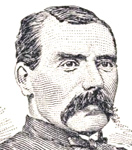 Open main menu
Open main menu
 Open main menu
Open main menu

J. Stewart
"Jock"
(1826 - 1905)
Home State: New York
Branch of Service: Artillery
Unit: 4th United States Artillery, Battery B
see his Battle Report
Before Antietam
A printer by training, he emigrated from Scotland to the US in 1844. At age 21 he enlisted as a Private in Battery B, 4th United States Artillery on 29 October 1851 in New York City. He reenlisted on 29 August 1856 at Fort Brown, TX, by then a Sergeant. In July 1860 he was with the Battery in Ruby Valley, Utah Territory, and he reenlisted at Fort Crittenden, UT on 1 July 1861. He was commissioned 2nd Lieutenant of the Battery on 15 November 1861, by then its First Sergeant.
On the Campaign
His section were the first Federal guns deployed into Miller's Cornfield at Antietam, and were joined there by the rest of the Battery during the First Army Corps' advance early on 17 September 1862. The Battery was crucial in helping to stop the charge of Hood's Division. Command of the Battery passed to Lieutenant Stewart after Captain Campbell was wounded. In an 1893 letter to John Gould, he noted:
About ten minutes after being placed in command I was struck by a minie ball breaking my waist belt plate and knocking me down. On getting up I found my sword belt broken in two. The shock was trouble for some time, but I knew if I should allow it to be known that I was wounded that someone else would be sent to command the battery. I suffered a great deal and had to use a catheter for many years and sometimes especially when I catch cold the old pain will come back. General Gibbon does not know to this day that I was wounded in the battle.
When the battle was over, in place of looking over the field and making notes I had to lie down flat on my back and obtain all the relief that I possibly could until the surgeon came and helped me out of the pain.
The rest of the War
He commanded the battery for the rest of the war, and was promoted to First Lieutenant on 3 July 1863. He was honored by brevets to Captain on 1 August 1864 for "gallant and meritorious service" at Spotsylvania Courthouse and during the campaign before Richmond, VA, and Major on 18 August 1864 for his service in the battle on the Weldon Railroad, VA.
After the War
He continued in Regular Army service and was appointed Captain, 18th US Infantry on 28 July 1866. He retired on 20 March 1879 at the rank of Major. He lived at Fort Thomas, KY, near Cincinnati.
References & notes
His service from Heitman1 and the Registers,2 source also of his birthplace. Further details from Silas Fenton's essay on the Battery in Nolan's Giants in Their Tall Black Hats: Essays on the Iron Brigade (1998) and from the US Census of 1860. His gravesite is on Findagrave; which says he was born in Edinburgh. His picture from an engraving after a photograph in Buell.3
He married Sabine (?) and, secondly, Rebecca Duffy (1848-1935), with whom he had 3 children between 1880 and 1888.
Birth
05/18/1826; Leith, Scotland
Death
04/19/1905; burial in Arlington National Cemetery, Arlington, VA
1 Heitman, Francis Bernard, Historical Register and Dictionary of the United States Army 1789-1903, 2 volumes, Washington DC: US Government Printing Office, 1903, Vol. 1, pg. 924 [AotW citation 10431]
2 US Army, Registers of Enlistments in the United States Army, 1798-1914, Washington, DC: National Archives, 1956, Vol. 49, pg. 227; Vol. 051, pg. 226 [AotW citation 27457]
3 Buell, Augustus, The Cannoneer: Recollections of Service in the Army of the Potomac, Washington: The National Tribune Company, 1890, frontpiece [AotW citation 10432]